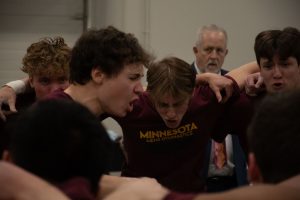Editor’s note: The University faces a multimillion-dollar budget gap between the cost to run the University and incoming revenues. This is the first of a three-part series that addresses why the University’s costs are rising faster than the rate of inflation, where the funding comes from to pay for these costs and how the University plans to resolve the budget issue — a resolution that includes a proposed tuition increase.
University President Mark Yudof calls it a “distribution problem.” Others call it a budget gap.
Regardless, this year the University must find $23 million to cover the difference between the cost to run the University and money coming in.
The gap is only a small percent of the University’s $1.6 billion operating budget. However, the systemwide costs of compensation, facilities and technology — which account for 85 percent of the shortfall — are spiraling upward faster than inflation and do not seem to be slowing down.
“The cost of making sure we keep pace … isn’t anything like the consumer price index,” said Bob Bruininks, University executive vice president and provost.
The consumer price index, a measure of changes in the retail prices of a constant marketbasket of goods and services, hovers near 2 percent.
Bruininks said higher education costs are rising at a much higher rate than average goods and estimated a rate of 10 percent. “It is a different basket of goods,” he said.
Competitive compensation
Higher education is an employee-intensive industry.
Last year, 61 percent of the University’s expenditures went to salaries and fringe benefits.
A 3 percent faculty salary raise, which Yudof requested from the Board of Regents earlier this month, would cost the University $28 million. Yudof proposed state money, individual college resources and a 5 to 6 percent tuition hike contribute to the pay raise.
“Three percent doesn’t even begin to make us competitive on faculty salaries,” Yudof said. “We will lose faculty over this issue.”
The University competes with private businesses and other nationally ranked universities to recruit and retain faculty and staff members in a very tight national job market. University faculty salaries presently rank 25th among the nation’s top 30 research universities.
“The market for faculty is somewhat like the market for sports stars,” said Marvin Marshak, a University physics professor and legislative liaison for the Extension Faculty Consultative Committee. Public universities paying more give them a recruiting advantage for the best faculty.
“To do something bold is not easy,” Marshak said.
Each 1 percent salary and fringe benefit increase requires $9.6 million in recurring funds. That does not include the additional costs for health, dental and disability insurance benefits — all of which continue to rise faster than inflation.
Fred Morrison, a University law professor and a committee chairman, said the 3 percent increase does not push the University toward the best, nationally, but instead “is a push to bring us toward the middle.”
During the past 10 years, he said, University faculty members experienced three years without any pay increase, five years with raises “at about inflation or less” and only experienced two years with what he considers reasonable pay increases.
Consistently ignoring the compensation issue is demoralizing for faculty members, Morrison added. With less than adequate funds, only “emergency cases” get merit raises causing others to lose out.
Faculty members not only want better pay, they also want bright graduate students and top-notch staff members. However, recruiting this research support to the University is made more difficult as these staff salaries currently rank ninth among the Big Ten institutions.
Outlets, overheads and operating tables
Faculty members and students demand laboratories, classrooms and other physical improvements from the University as a matter of both preference and need.
The latest round of construction tried to meet some of this demand, adding 300 classrooms on the Twin Cities campus. This raised the number of classrooms to an “adequate” level, yet the quality is lacking.
Sixty-six percent of the Twin Cities classrooms are below the basic physical and functional standards, 75 percent lack video/data projection capacity and 73 percent lack Internet access.
Physical and functional upgrades would cost more than $20 million. Technology upgrades would tack on another $7 million.
In 1998, the University received legislative funding for several new and renovated facilities. But state money did not pay for everything.
In addition to managing the building projects’ double-digit, million-dollar debt, the University also pays a recurring cost to maintain and operate the facilities.
Hidden costs of bringing the electrical outlets up to code, utility expenses for newly installed air conditioning and other expenses not included in the legislative package all must be paid for and raise the cost to run the University.
Taste for technology
PeopleSoft’s $60 million price tag sent shock waves through the University community because of the system’s unexpected costs and service problems. Yet, despite its cost, this software was a must in getting the University’s outdated computer system ready for tuition conversion, potential millennium glitches and online student services.
Delayed and overlooked technology improvements, such as the systems that PeopleSoft replaced and the Twin Cities’ 14-year-old telephone system, which has outlived its anticipated life of 10 years, contribute to rising costs. Replacing the telephone system will cost an estimated $15 million.
In addition to essential improvements, the University’s appetite for cutting-edge educational opportunities drives costs upward.
“The computer revolution means we’re spending a lot more money on things we didn’t spend in the 1940s … things that students now wouldn’t dream of doing without,” said Peter Zetterberg, the University’s institutional research and reporting director.
For instance, the University has doubled its consumption of commercial Internet capacity every year since 1991.
Technology staff members are expensive to recruit and retain. The University suffers replacement costs for those who leave for better paying jobs with more attractive technology.
The three rising costs of compensation, facilities and technology are interrelated. Top-notch facilities attract talented faculty and staff members who demand competitive compensation and cutting-edge technology.
As the University invests in compensation, facilities and technology — in an effort to compete in the research and education marketplace — it must address the rising costs inherent in these expenditures.
Zetterberg said going all the way back to the 1940s, “the University’s aspirations exceeded its resources.” But in the end, the University’s budget must balance.
Part two and three in this series will address funding and budget challenges the University faces this year and in the years ahead.
Kristin Gustafson covers University administration and federal government and welcomes comments at [email protected].
Daily Email Edition
Get MN Daily NEWS delivered to your inbox Monday through Friday!

Published May 3, 2024

Published May 3, 2024

Published May 3, 2024
Trending
U seeks fix for budget issue
Published March 22, 2000
Leave a Comment
Advertisement
The Minnesota Daily • © 2024 The Minnesota Daily • Privacy Policy • FLEX Pro WordPress Theme by SNO • Log in







